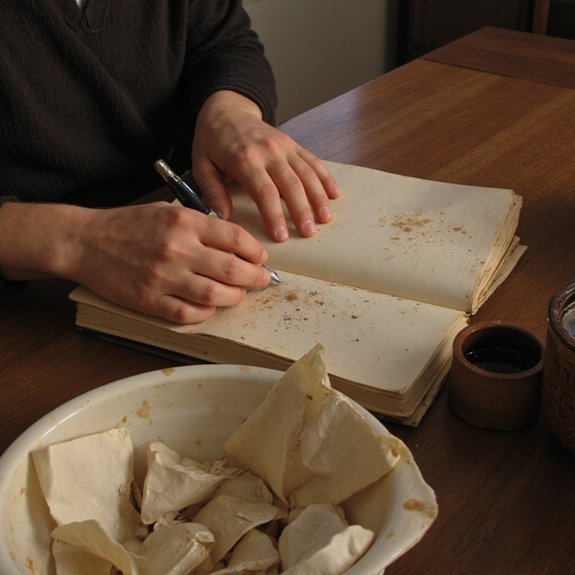Start by listening to how you speak: the rhythms, hesitations, favorite turns of phrase. Read broadly to map influences, then write daily without censor to capture raw cadence. Try different tones and perspectives, trim what feels borrowed, and keep the words that sting. Share drafts for precise feedback, and let revision coax the voice you recognize—if you’ll risk honesty, the rest depends on what you refuse to hide.
Key Takeaways
- Record and study how you speak; imitate then translate those rhythms and idioms into your writing.
- Read widely and catalogue passages that resonate to reveal recurring influences and preferred techniques.
- Write daily without self-editing to surface natural cadences, images, and recurring phrases.
- Experiment with tone and point of view by rewriting scenes in multiple voices to discover what feels authentic.
- Seek focused peer feedback and iterate, distinguishing surface edits from deep revisions that shape your signature voice.
Listen to the Way You Speak

How do you speak when no one’s watching? You note your speech patterns, the pauses, idioms, and habitual cadences that surface when pressure drops. Listen not to what you think you should say but to the micro-rhythms that reveal authenticity: clipped irony, warm asides, skeptical lifts. You record brief samples, then analyze them for recurrent habits and surprising turns; patterns become data, data becomes a lexicon you can deploy deliberately. Aim for a conversational tone that feels engineered rather than accidental — precise, adaptive, and recognizably yours. Invention grows from disciplined mimicry: you emulate your best self’s inflections and streamline distractions. Practice transforming spoken instincts into written strategies — variable sentence length, rhetorical questions, deliberate contractions — so your prose breathes like speech. The result isn’t imitation; it’s an authored voice informed by lived vocal behavior, ready to innovate while remaining unmistakably human. Trust those patterns and refine with intentional, iterative experiments regularly.
Read to Discover Your Influences

As you read widely, mark the passages that arrest you and catalogue why they work. Note recurring themes across authors and genres to reveal the ideas that magnetize your curiosity. Over time you’ll identify voice patterns—rhythms, syntactic choices, tonal tics—that quietly steer your own phrasing.
Track Favorite Passages
Select a handful of passages you keep returning to and study them like artifacts: note their sentence length, punctuation, figurative moves, and the precise moments that make you lean in. You trace favorite inspirations and memorable styles, cataloguing cadences, risks, and the rhetorical turns you crave. You’ll annotate where voice bends toward intimacy or invention, then practice those moves in micro-experiments. Below, sample elements to track:
| Element | Why it matters |
|---|---|
| Rhythm | Shapes reader momentum |
| Syntax | Reveals authorial signature |
| Imagery | Sparks associative leaps |
Treat these notes as a laboratory. Repeat, remix, and adapt with fidelity to your own sensibility; innovation grows from disciplined mimicry, not imitation. Keep the record portable, tagging passages by effect so you can iterate quickly and test what truly resonates today.
Note Recurring Themes
Anyone who wants to discern their influences should read with an ear for recurring themes: notice the images, concerns, and ethical questions that keep reappearing across books and essays, and ask why they grab you. When you catalog motifs—loss, curiosity, urban alchemy—you perform deliberate theme exploration that clarifies which ideas magnetize your imagination. Keep notes that connect emotional resonance to intellectual attraction; they’ll reveal why certain metaphors feel inevitable. You won’t copy others, you’ll inherit a set of preoccupations you can interrogate and recombine. This is voice reflection in action: an analytical, aesthetic inventory that primes invention. By isolating recurring commitments, you deepen your authorship, choosing which inheritances to honor, which to subvert, and how to translate influence into original work. With confident nuance.
Identify Voice Patterns
Reading closely will show you the structural fingerprints authors leave—rhythms, sentence shapes, favored verbs, recurring metaphors—that quietly steer their voice, and you’ll learn to spot the same signatures in your reading. As you practice voice analysis, map cadence, diction, and syntactic preferences; note where punctuation creates tension or ease. You’ll compare passages, isolating recurring motifs and tonal pivots, then ask how those choices serve meaning. This style exploration becomes a toolkit: prototypes you can recombine to innovate without imitation. Don’t mimic superficially—translate techniques into your aesthetic logic. Over time you’ll internalize patterns until they inform decisions instinctively, letting you craft work that’s recognizably yours yet enriched by deliberate, borrowed virtuosity. Use those observations to experiment boldly, refining a voice that evolves with deliberate purpose.
Write Regularly Without Self‑Editing

When you commit to writing regularly without self‑editing, you open a channel that favors discovery over polish, letting raw associations surface before your inner critic intervenes. You cultivate a discipline where habit trumps hesitation: daily sessions, even ten minutes, rewire your predictive censor and expand what you’ll allow onto the page. Use stream of consciousness and free writing to map thought patterns, not to sculpt prose; treat drafts as research instruments that reveal your cognitive rhythms. Don’t stop to fix syntax or prune metaphors—notice recurring images, logical leaps, favored cadences. Later, with analytic distance, you’ll harvest material for refinement. This regimen accelerates voice formation because it privileges authentic velocity over retrospective control; you’ll locate distinctive tonal impulses and rhetorical gestures that editing often flattens. Stay curious, track emergent motifs, and let accumulation, not perfectionism, guide you toward an innovative, unmistakable voice. You’ll refine through iterative, deliberate, purposeful revision.
Experiment With Tone and Point of View
Although shifting tone and point of view can feel risky, you should treat them as controlled experiments—swap first for third, tighten a distant narrator into intimate free indirect discourse, or let an unreliable voice undermine apparent facts—to expose different contours of your material and reveal latent attitudes. You’ll run systematic tone exploration by isolating a scene and rewriting it in multiple voices: the confessional “I”, the clinical observer, the sardonic aside. You’ll test perspective shifts by changing focalizers and measuring how empathy, irony, and authority reconfigure meaning. Keep meticulous notes on reader response, rhythm, and what feels true versus performed. Reject one-size-fits-all solutions; patterns will emerge that point to your signature choices. These trials sharpen judgment, surface risks you can harness, and teach you when restraint or exuberance best serves your impulse to innovate. Embrace iteration: each variant refines what only you can convincingly say, and claim them.
Trim, Shape, and Own Your Language
Prune your prose until every word earns its place: ruthless reduction reveals the muscles beneath the ornament and clarifies what you want to say. You pare clichés, cut passive constructions, and let syntax sing; trimming is a deliberate act of curation that accelerates your language evolution and sharpens personal expression. Shape sentences to carry rhythm and intent, favoring verbs over hedges, specific nouns over abstractions. Own idioms that fit you, discard those that don’t, and build a vocabulary that’s both precise and unfamiliar enough to surprise. Practice micro-edits: reduce clauses, swap modifiers, test cadence aloud. Use these tactical moves to make your voice distinct:
- Strip redundancies; each sentence must pull its weight.
- Choose collisions of words that illuminate, not confuse.
- Favor clarity that still invites curiosity and innovation.
- Guard consistency in tone so your personality reads through structure.
You’ll produce writing that feels inevitable, usable, and unmistakably yours.
Seek Feedback and Revise Strategically
Because feedback acts like a mirror and a scalpel, you should solicit it with intent: choose readers who’ll stretch your assumptions, point out brittle logic, and highlight where your voice falters or sings. Then set precise questions—ask peer reviews to focus on cadence, clarity, and originality rather than generic praise. You’ll separate surface edits from deep revision by cataloging patterns in constructive criticism: recurring objections reveal structural blind spots; recurrent praise shows signature moves worth amplifying. You should iterate in focused passes—one for argument, one for diction, one for rhythm—so each revision sharpens the voice without flattening idiosyncrasy. Treat feedback as data: map comments, weigh their provenance, and decide which changes align with your expressive aim. Be prepared to defend choices when necessary, and to surrender cherished lines when evidence demands. That disciplined reciprocity—rigorous listening plus decisive revision—lets your voice evolve with clarity, risk, and originality and confidence.
Build a Sustainable Writing Ritual
You cultivate your voice by making writing a daily habit that trains attention and muscle memory. Reserve consistent time blocks—short, regular sessions that respect your rhythms—to let ideas settle and language refine. Over time, those disciplined moments reveal the contours of your singular tone.
Daily Writing Habit
When you commit to a modest daily ritual, small increments of practice compound into the discipline that reveals and refines your voice. You’ll use short exercises—writing prompts, snippets, free association—to probe language limits and surface original rhythms. Keep it manageable: you want a habit that survives disruption. Pair micro-goals with reflection so you notice patterns, cadences, and rhetorical tendencies. Daily journaling anchors attention and supplies raw material to remix later. Cultivate variation: shift genre, tone, persona, medium. Track progress analytically, then trust intuition. A concise checklist helps you stay curious and experimental:
- One focused warm-up five minutes
- A targeted prompt or research note
- Risky sentence-making, break rules
- Brief reflective note on what changed
This practice accelerates innovation and clarifies future bold work ahead, always.
Consistent Time Blocks
Three consistent time blocks each week anchor a sustainable writing ritual. You designate specific segments—morning reflection, midday drafting, evening revision—so your craft becomes predictable and poised for innovation. By treating those blocks as obligations, you impose a gentle structure that optimizes time management and primes neural pathways for creative elaboration. In a focused environment you reduce friction: eliminate notifications, set minimal tools, and create sensory cues that signal writing mode. You’ll notice accelerated depth, clearer argumentation, and a growing signature cadence as repetition sculpts habits. Analyze outcomes after each block, adjust durations, and protect the slots against opportunistic tasks. This disciplined yet flexible architecture lets your voice emerge reliably, refined by iteration rather than sporadic inspiration and sustained by deliberate curiosity and persistent practice.

